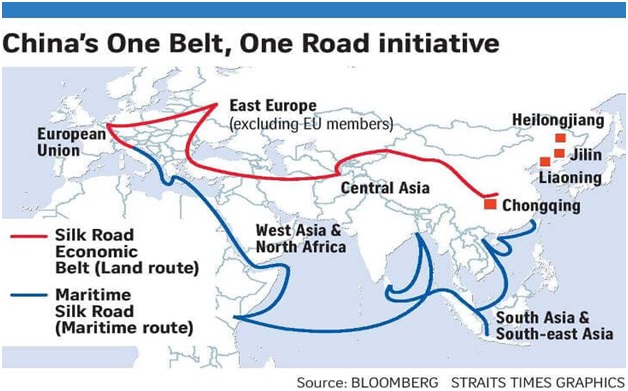10 Years of China's Visionary Belt and Road Initiative (The Hindu)

- 20 Oct 2023
Why is it in the News?
Recently Chinese President Xi Jinping commemorated the 10th anniversary of the Belt and Road Initiative (BRI).
What is the Belt and Road Initiative (BRI)?
- The Belt and Road Initiative (BRI), also known as the One Belt, One Road (OBOR) initiative, is a massive infrastructure and economic development project launched by China.
- It was introduced by Chinese President Xi Jinping in 2013 and aims to enhance trade and investment connectivity between China and various countries in Asia, Europe, Africa, and beyond.
- The initiative comprises two main components:
- The Silk Road Economic Belt: This land-based component envisions the construction of a network of roads, railways, and pipelines connecting China to Europe through Central Asia, the Middle East, and Eastern Europe.
- Maritime Silk Road: This sea-based component focuses on developing a network of ports and coastal infrastructure, linking China to Southeast Asia, South Asia, Africa, and Europe via the Indian Ocean and South China Sea.
What are the objective of the Belt and Road Initiative (BRI)?
- The BRI aims to stimulate economic development, improve trade relationships, and foster cultural exchanges across participating countries.
- It involves extensive investments in infrastructure, including roads, railways, ports, and energy projects, with the goal of boosting economic growth and connectivity.
- The initiative has been met with both enthusiasm and scrutiny, as it has the potential to reshape global trade and geopolitical dynamics.
- It is scheduled to be finished in 2049, to coincide with the centennial of the People's Republic of China.
Geographic Corridors:
The land-based Silk Road Economic Belt envisions six key development corridors:
- China-Pakistan Economic Corridor (CPEC).
- New Eurasian Land Bridge Economic Corridor.
- China-Indochina Peninsula Economic Corridor.
- China-Mongolia-Russia Economic Corridor.
- China-Central Asia-West Asia Economic Corridor.
- China-Myanmar Economic Corridor.
What is India's position on BRI?
- India objects to the project on the grounds of transparency and national sovereignty. India has boycotted China's BRI summits in 2017 and 2019 and has not endorsed the BRI joint statements issued by the Shanghai Cooperation Organization (SCO).
- The main reason India opposes the BRI is that it includes the China-Pakistan Economic Corridor (CPEC), which passes through Pakistan-occupied Kashmir (PoK), which India claims as its own territory.
- India also contends that BRI projects must adhere to international norms, the rule of law, and financial sustainability, and must not create debt traps or environmental and social risks for host countries.
- India has instead advocated for other connectivity programs, such as the Partnership for Global Infrastructure and Investment (PGII), a G7 program to finance infrastructure projects in developing nations.
What are the concerns related to the Belt and Road Initiative (BRI)?
- Debt burden: The debt sustainability and transparency of BRI projects, particularly in countries with weak governance, high corruption, and low credit ratings.
- Some critics have accused China of engaging in "debt-trap diplomacy" by lending money to countries like Sri Lanka and Zambia that eventually find themselves unable to repay, and then seizing strategic assets or extracting political concessions in exchange.
- Geostrategic Concerns: The Belt and Road Initiative has raised geopolitical concerns, particularly about China's growing influence and control over critical infrastructure in partner countries.
- Because of these concerns, some countries have reconsidered their participation in the initiative.
- Political Tensions: Geopolitical rivalries and disputes, such as the India-China border dispute, have hampered BRI project implementation in some regions.
- The progress of the initiative could be hampered by these political tenses.
- Multilateral Governance: The BRI is not a multilateral initiative, but rather a collection of mostly bilateral projects. This decentralized approach may cause coordination and governance issues.
- Unlike initiatives such as the Asian Infrastructure Investment Bank (AIIB), the BRI lacks a centralized governing structure, making collective action difficult.
- Environmental and social concerns: The BRI's infrastructure development projects have been criticized for their potential environmental and social impacts.
- It is difficult to ensure that BRI projects are environmentally sustainable and take into account the well-being of local communities.
Alternatives to BRI concerns include:
- Blue Dot Network (BDN): A multi-stakeholder initiative led by the United States, Japan, and Australia to promote high-quality global infrastructure development standards.
- B3W Initiative: The B3W Initiative, led by the G7, seeks to address the infrastructure gap in developing and low-income countries.
- Global Gateway: The European Union launched the Global Gateway to compete with BRI, focusing on various sectors such as climate change, digitalization, health, and education.
- PGII (Partnership for Global Infrastructure and Investment): A rebranded version of B3W. It is a G7 initiative to fund infrastructure projects in developing countries. India is in favor of it.
- India's Efforts:
- India's counter to BRI, supported by Lines of Credit (LOCs) to countries in Asia, Africa, the Commonwealth of Independent States (CIS), and Latin America.
- It includes projects such as IMEC and INSTC.
- During the recent G20 summit, India-Middle East-Europe Economic Corridor (IMEC) initiative
- International North-South Transport Corridor (INSTC) connecting India to the Middle East and Russia
To protect its own interests, China has established a network of investments that has left several low- and middle-income countries in severe debt; thus, global initiatives have provided a counter-block for monopoly and taken steps to focus on more inclusive and sustainable development.
